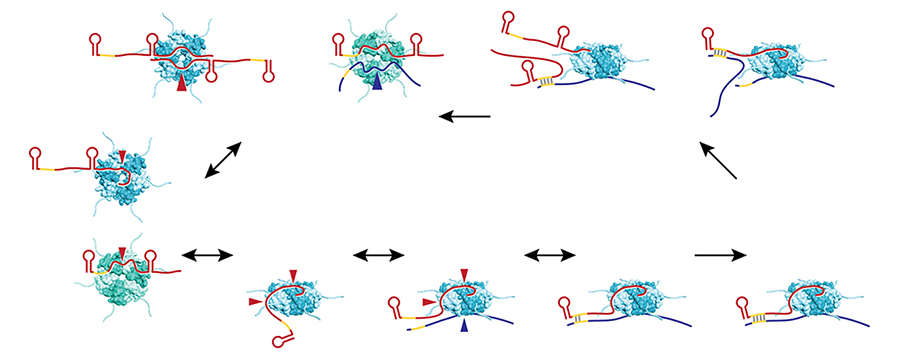Regulatory Small RNAs and Small Proteins

- Gisela Storz, PhD, Head, Section on Environmental Gene Regulation
- Aixia Zhang, PhD, Staff Scientist
- Philip P. Adams, PhD, Postdoctoral Fellow
- Tamira K. Butler-Lively, PhD, Postdoctoral Fellow
- Andrew B. Kouse, PhD, Postdoctoral Fellow
- Sahar S. Melamed, PhD, Postdoctoral Fellow
- Medha V. Raina, PhD, Postdoctoral Fellow
- Mona Wu Orr, PhD, Postdoctoral Fellow
- Jeremy S. Weaver, PhD, Postdoctoral Fellow
- Joshua M. Mills, BS, Postbaccalaureate Fellow
- Leana M. Ramos, BS, Postbaccalaureate Fellow
- Hira Shabbir, BS, Postbaccalaureate Fellow
- Hanbo Wang, BS, Graduate Student
Currently, we have two main interests: identification and characterization of small noncoding RNAs and identification and characterization of proteins of less than 50 amino acids. Both small RNAs and small proteins have been overlooked because they are not detected in biochemical assays, and the corresponding genes are poorly annotated and missed in genetic screens. However, mounting evidence suggests that both classes of small molecules play important regulatory roles.
Identification and characterization of small regulatory RNAs
During the past 20 years, we have carried out several different systematic screens for small regulatory RNA genes in Escherichia coli. The screens included computational searches for conservation of intergenic regions and direct detection after size selection or co-immunoprecipitation with the RNA–binding protein Hfq. We recently examined small RNA expression using deep sequencing to further extend our identification of small RNAs, particularly antisense RNAs.
A major focus for the group has been to elucidate the functions of the small RNAs we and others identified. Early on, we showed that the OxyS RNA, whose expression is induced in response to oxidative stress, acts to repress translation through limited base pairing with target mRNAs. We discovered that OxyS action is dependent on the Sm–like Hfq protein, which acts as a chaperone to facilitate OxyS RNA base pairing with its target mRNAs (Reference 1). Recently, we also started to explore the role of ProQ, a second RNA chaperone in E. coli (Reference 2).
It is now clear that Hfq–binding small RNAs, which act through limited base pairing, are integral to many different stress responses in E. coli and other bacteria (Reference 3). For example, we showed that the Spot 42 RNA, whose levels are highest when glucose is present, plays a broad role in catabolite repression by directly repressing genes involved in central and secondary metabolism, redox balancing, and the consumption of diverse nonpreferred carbon sources. Similarly, we discovered that a Sigma(E)-dependent small RNA, MicL, transcribed from a promoter located within the coding sequence of the cutC gene, represses synthesis of the lipoprotein Lpp, the most abundant protein in the cell, to oppose membrane stress. We found that the copper-sensitivity phenotype previously ascribed to inactivation of the cutC gene is actually derived from the loss of MicL and elevated Lpp levels. The observation raises the possibility that other phenotypes currently attributed to protein defects are attributable to deficiencies in unappreciated regulatory RNAs.
Most recently, we characterized a set of small RNAs expressed from a locus we denoted sdsN (Reference 4). Two longer sRNAs, SdsN137 and SdsN178, are transcribed from two Sigma(S)-dependent promoters but share the same terminator. Whole genome expression analysis after pulse overexpression of SdsN137 and assays of lacZ fusions revealed that SdsN137 directly represses the synthesis of the nitro-reductase NfsA, which catalyzes the reduction of the nitro-group (NO2) in nitro-aromatic compounds, and the flavohemoglobin HmpA, which has aerobic nitric oxide (NO) dioxygenase activity. Consistent with this regulation, SdsN137 confers resistance to nitrofurans. Interestingly, SdsN178 is defective in regulating the above targets as a result of unusual binding to the Hfq protein, but cleavage leads to a shorter form, SdsN124, able to repress nfsA and hmpA.
In addition to small RNAs that act via limited base pairing, we have been interested in regulatory RNAs that act by other mechanisms. For example, early work showed that the 6S RNA binds to and modulates RNA polymerase by mimicking the structure of an open promoter. In a more recent study, we discovered that a broadly conserved RNA structure motif, the yybP-ykoY motif, found in the 5′-UTR of the mntP gene, which encodes a manganese exporter, directly binds to manganese, resulting in a conformation that liberates the ribosome-binding site. Remarkably, we were able to recapitulate the effect of manganese-dependent activation of translation in vitro. We also found that the yybP-ykoY motif responds directly to manganese ions in Bacillus subtilis. The identification of the yybP-ykoY motif as a manganese ion sensor suggests that the genes preceded by this motif that encode a diverse set of poorly characterized membrane proteins, have roles in metal homeostasis.
Further studies to characterize other Hfq–binding RNAs and their evolution as well as antisense RNAs and small RNAs that act in ways other than base pairing are ongoing.

Click image to enlarge.
Figure 1. Model of Hfq–facilitated base pairing between sRNAs and mRNAs
E. coli Hfq (teal for the proximal face and rim views and green for the distal face view) employs four solvent-exposed surfaces to interact with RNA; sRNAs (red) have been found to contact the proximal and distal faces, rim, and C-terminus, and mRNAs (blue) have been shown to contact the distal face, rim, and C-terminus. Red and blue arrows denote sRNA and mRNA binding to Hfq, respectively. Hfq binding to mRNAs and sRNAs is thought to occur in random order. Initial binding is likely to involve only a subset of subunits, allowing for rapid displacement by other RNAs. Many RNAs bind to multiple surfaces, resulting in changes in RNA secondary structure and protection against RNase degradation, particularly for sRNAs. The free surface(s) of Hfq not already bound to RNA interacts with the cognate RNA partner, positioning the unbound seed region of the sRNA in close proximity to the unbound complementary region of the mRNA, facilitating base pairing. The lower affinity of duplex RNA for Hfq causes free RNAs to compete off sRNA–mRNA pairs, allowing Hfq to serve as a matchmaker for another pair of RNAs.
Identification and characterization of small proteins
In our genome-wide screens for small RNAs, we found that several short RNAs actually encode small proteins. The correct annotation of the smallest proteins is one of the biggest challenges of genome annotation, and there is little evidence that annotated short open reading frames (ORFs) encode synthesized proteins. Although these proteins have largely been missed, the few small proteins that have been studied in detail in bacterial and mammalian cells have been shown to have important functions in signaling and in cellular defenses. We thus established a project to identify and characterize proteins of less than 50 amino acids.
We used sequence conservation and ribosome binding–site models to predict genes encoding small proteins of 16–50 amino acids, in the intergenic regions of the model Escherichia coli genome. We tested expression of these predicted proteins as well as previously annotated small proteins by integrating the sequential peptide affinity tag directly upstream of the stop codon on the chromosome and assaying for synthesis using immunoblot assays. The approach confirmed that 20 previously annotated and 18 newly discovered proteins of 16–50 amino acids are synthesized. We have now initiated complementary biochemical approaches to identify additional small proteins.
More than half the newly discovered proteins were predicted to consist of a single transmembrane alpha-helix and were found to be in the inner membrane in biochemical fractionation. Interestingly, assays of topology-reporter fusions and strains with defects in membrane insertion proteins revealed that, despite their diminutive size, small membrane proteins display considerable diversity in topology and insertion pathways. Additionally, systematic assays for the accumulation of tagged versions of the proteins showed that many small proteins accumulate under specific growth conditions or after exposure to stress. We also generated and screened bar-coded null mutants and identified small proteins required for resistance to cell-envelope stress and acid shock.
We now are using the tagged derivatives and information about synthesis and subcellular localization and employing many of the approaches the group has used to characterize the functions of small regulatory RNAs to elucidate the functions of the small proteins. The combined approaches are beginning to give insights into how the small proteins are acting in E. coli.
We found that synthesis of a 42–amino acid protein, now denoted MntS (formerly the small RNA gene rybA) is repressed by high levels of manganese through MntR. The lack of MntS leads to reduced activities of manganese-dependent enzymes under manganese-poor conditions, while overproduction of MntS leads to very high intracellular manganese and bacteriostasis under manganese-rich conditions. These and other phenotypes led us to propose that MntS modulates intracellular manganese levels, possibly by inhibiting the manganese exporter MntP (Reference 5).
We also discovered the 49–amino acid inner membrane protein AcrZ (formerly named YbhT), whose expression is induced by noxious compounds such as antibiotics and oxidizing agents, associates with the AcrAB-TolC multidrug efflux pump, which confers resistance to a wide variety of antibiotics and other compounds. Co-purification of AcrZ with AcrB, in the absence of both AcrA and TolC, two-hybrid assays and suppressor mutations indicate this interaction occurs through the inner membrane protein AcrB. Mutants lacking AcrZ are sensitive to many of, but not all, the antibiotics transported by AcrAB-TolC. The differential antibiotic sensitivity suggests that AcrZ enhances the ability of the AcrAB-TolC pump to export certain classes of substrates.
We showed that the 31–amino acid inner membrane protein MgtS (formerly denoted YneM), whose synthesis is induced by very low Mg2+ in a PhoPQ–dependent manner, acts to increase intracellular Mg2+ levels and maintain cell integrity upon Mg2+ depletion (Reference 6). Upon development of a functional tagged derivative of MgtS, we found that MgtS interacts with MgtA to increase the levels of this P-type ATPase Mg2+ transporter under Mg2+-limiting conditions. Correspondingly, the effects of MgtS upon Mg2+ limitation are lost in an mgtA mutant, and MgtA overexpression can suppress the mgtS phenotype. MgtS stabilization of MgtA provides an additional layer of regulation of this tightly controlled Mg2+ transporter.
This work, together with our ongoing studies of other small proteins (Reference 7) and related findings by others in eukaryotic cells, supports our hypothesis that many small proteins act as regulators of larger membrane proteins.
Publications
- Updegrove TB, Zhang A, Storz G. Hfq: the flexible RNA matchmaker. Curr Opin Microbiol 2016 30:133-138.
- Olejniczak M, Storz G. ProQ/FinO-domain proteins: another ubiquitous family of RNA matchmakers? Mol Microbiol 2017 104:905-915.
- Machner MP, Storz G. Infection biology: small RNA with a large impact. Nature 2016 529:472-473.
- Hao Y, Updegrove TB, Livingston NN, Storz G. Protection against deleterious nitrogen compounds: role of sigmaS-dependent small RNAs encoded adjacent to sdiA. Nucleic Acids Res 2016 44:6935-6948.
- Storz G. New perspectives: insights into oxidative stress from bacterial studies. Arch Biochem Biophys 2016 595:25-27.
- Wang H, Yin X, Wu Orr M, Dambach M, Curtis R, Storz G. Increasing intracellular magnesium levels with the 31-amino acid MgtS protein. Proc Natl Acad Sci USA 2017 114:5689-5694.
- Raina M, Storz G. Sort, a small protein that packs a sweet punch. J Bacteriol 2017 199:e00130-17.
Collaborators
- Matthias P. Machner, PhD, Section on Microbial Pathogenesis, NICHD, Bethesda, MD
- Mikolaj Olejniczak, PhD, Institute of Molecular Biology and Biotechnology, Adam Mickiewicz University, Poznan, Poland
Contact
For more information, email storz@helix.nih.gov or visit http://storz.nichd.nih.gov.


